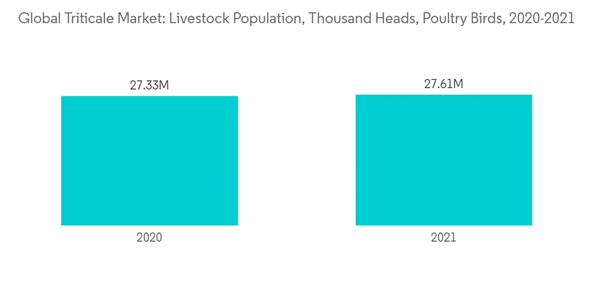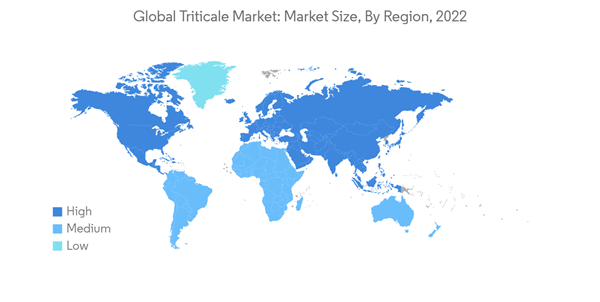Key Highlights
- Triticale is gaining popularity among livestock growers across the globe as it can be used in animal feed. Triticale has digestibility and water-soluble sugars similar to oats and cereal rye. Additionally, triticale can also thrive in drought, low-fertile soil, attracting more forage and livestock growers. This increasing adoption of triticale in animal feed is one of the major driving factors for the global triticale market.
- The leaders in the production of this crop are Poland and Germany. These countries have developed varieties that have occupied the main niche in the feed industry, and it can be difficult for other countries to compete in this area. At the same time, there are some peculiarities - in particular, despite good immunity, triticale often picks up a disease such as snow mold, and sometimes it is affected by septoria. Because of this, breeders are constantly working on obtaining new, more resistant plant varieties.
- Geopolitical issues have become the primary driver for the spring wheat market and other grain markets, with signs of Russia increasing its war efforts in Ukraine, which will benefit the market and raise the market during the forecast period.
Triticale Market Trends
Increasing use of triticale in Animal Feed in North America
Triticale has been increasingly used in animal feed by livestock growers. This can also be used as a substitute for oats and cereal rye. In the United States, North Florida Research and Education Center have developed triticale varieties such as Trical 342 and Monarch, the majorly grown triticale varieties for forage.According to a study conducted in Florida, North Dakota, and Canada, the performance of finisher pigs fed with triticale was similar to those fed with corn. The lower price of triticale compared to corn will attract more livestock growers to use triticale in animal feed. According to FAO, the global poultry birds populations was 27,329,218 Thousand Heads in 2021, which was slightly increased compared to the previous year. This will drive the market for North American triticale in the upcoming years.
Based on current knowledge of triticale grains used to produce concentrated animal feeds. As a forage plant, triticale has a higher yield than other real cereals; triticale should be sown with some of the grain legumes to increase the protein value of vegetative biomass. In Canada and the United States, certain areas under winter species of triticale serve as pasture for domestic animals, boosting the market in the coming years.
Europe is the Major Producer of Triticale
In Europe, Poland is the largest producer of triticale globally, and domestic crops of this cereal account for 1/3 of the global production and more than 40% of the Europe production, and the share of production structure increased to 55%.According to the Food and Agriculture Organization of the United Nations (FAO), in 2020, Poland, Germany, and France accounted for nearly 60% of the global production of this cereal. Currently, triticale is one of the most cultivated cereals in Poland, occupying second place after wheat. The cultivation area of the crop occupies over 1.4 million hectares which was slightly increased compared to the previous year with 1.3 million hectares with a share of 19%, and more than 50% of crops are located in the Wielkopolskie, Mazowieckie, Łódzkie and Lubelskie Voivodeships.
The main factors causing changes in cereal consumption in Poland are fluctuations in the animal population and grain for sowing, which is used in the feed, biofuel, and processing industries. This will drive the market during the forecast period.
Additional Benefits:
- The market estimate (ME) sheet in Excel format
- 3 months of analyst support
This product will be delivered within 2 business days.










